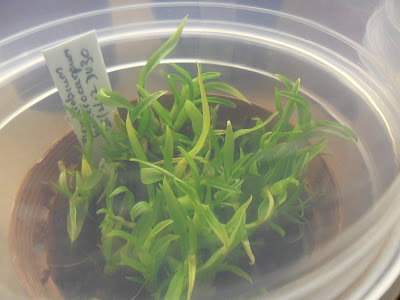Well, since I have recently been wading through loads of bureaucracy that our South African government departments are so fond of, I have decided that it would be useful to know what the regulations are regarding the importation of orchid flasks and plants into South Africa. So, when you next consider importing some flasks and plants for your collection, remember the following and avoid tears at Customs.
The regulations for importing orchids or flasks of orchids are governed by the Agricultural Pests Act (Act 36 of 1983), given regulation R1013: Importation of Controlled Goods Without a Permit (26 May 1989). The Act can be obtained
here. Regulation R1013 can be obtained
here.
You DO NOT need to fill out an application for an import permit for orchid flasks or orchid plants under the Act. Regulation R1013 makes provision for this providing the following conditions of excemption:
a. The applicable requirements specified in column 2 of Table 1 opposite a particular class of controlled goods shall be complied with in respect of each consignment of that class of controlled goods. [This is referring to Regulation R1013 where plant families and physical parts thereof are listed in Table 1 with or without connecting restrictions as a code number with definitions given in the regulation]
b. The controlled goods concerned may only be imported through a port of entry specified in Table 3.
c. Each consignment of controlled goods shall be presented to the executive officer at the port of entry thereof for such inspection as he may deem necessary.
d. The certificate [here they are referring to your Phytosanitary certificate which you will need to obtain] that accompanies a consignment of controlled goods shall be retained by the executive officer.
e. No consignment of controlled goods may be removed from the port of entry thereof before the executive officer has consented thereto in writing.
Table 1.
Controlled goods exempted from permits, and requirements of exemption
"Phytosanitary certificate is required but no additional declaration is required: Orchidaceae"
"6. Tissue culture in vitro of species of the following genera and families: Orchidaceae [with code AD 8]"
Definitions of code generated for 6.
(j) "AD 8" means that the applicable certificate [your phytosanitary certificate] shall contain an additional declaration that the tissue culture or tissue culture transplants comprising the consignment concerned was obtained from mother plants that are practically free from virus and other diseases.
Summary
1. You dont need an import permit
2. You need a phytosanitary certificate for both flasks and orchid plants imported
3. You need an additional declaration on the phytosanitary certificate for flasks stating that the mother stock of the tissue culture is practically free of virus and other diseases




























